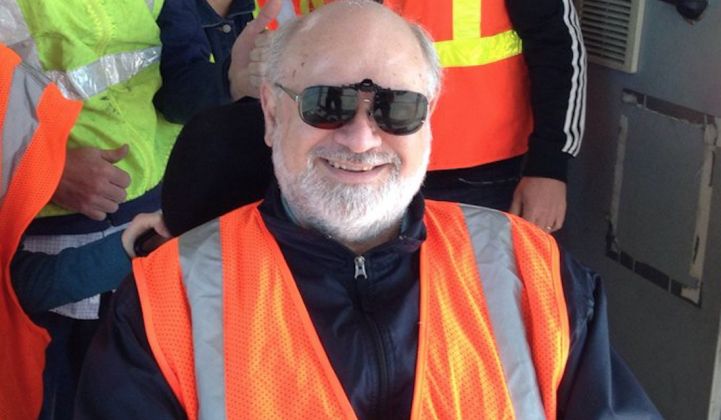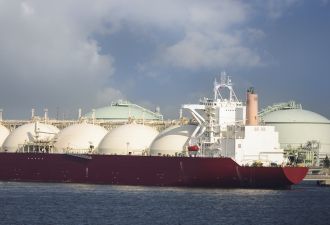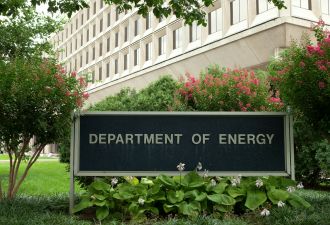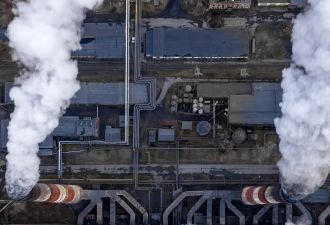Utility regulation isn’t known for its thrills, but it certainly hasn’t been dull for Mike Florio.
“It’s been a wild ride,” said the California commissioner, in a recent interview. “It hasn’t always been fun…but overall I’ve enjoyed it.”
Governor Jerry Brown appointed Florio to the California Public Utilities Commission on January 25, 2011. Now, nearing the end of his six-year term, Florio will attend his final meeting as a commissioner on December 15.
Florio was appointed in the wake of the San Bruno pipeline explosion. Regulators had barely gotten that issue under control when the CPUC started having to cope with the San Onofre nuclear plant shutdown, followed shortly after by the Aliso Canyon gas leak. Florio learned quickly that reality likes to get in the way of best-laid plans.
“You can’t really come in and say, ‘I’m going to do "x,"’ because the world intervenes and has other ideas,” he said.
But while the work has not been easy or without controversy, the CPUC has had no shortage of accomplishments on clean energy during Florio’s term.
'Vision and leadership'
When asked, one of the big successes Florio highlighted was replacing power from the shuttered San Onofre plant predominantly with “preferred resources” -- such as renewable energy, efficiency improvements, demand response and energy storage. Florio said he was also proud to see the California hold the first solicitation where energy storage was explicitly included as a resource, and then see Southern California Edison (SCE) contract for five times the targeted amount.
Commissioner Florio, who previously served as a senior attorney at The Utility Reform Network, is widely heralded as a cleantech-friendly regulator. "Commissioner Florio's vision and leadership has created critical momentum on opening up California's electricity system to innovation and greater consumer choice,” Steve Chadima, director of California initiatives for Advanced Energy Economy, wrote in an email.
He was particularly instrumental in putting energy storage on a level playing field with other types of preferred resources and for requiring utilities to start buying it, according to Janice Lin, executive director of the California Energy Storage Alliance (CESA). In 2013, Florio mandated that SCE procure 50 megawatts of energy storage as part of the long-term procurement planning process. In response, SCE ultimately procured more than 250 megawatts of energy storage as part of a larger resource package.
“The 50-megawatt requirement was kind of tiny in the big picture, but it really made history,” said Lin.
The 50-megawatt requirement came several months before the CPUC set the 1.3-gigawatt energy storage target for the state’s big three investor-owned utilities, although SCE’s more than 250 megawatts of contracted energy storage have now been counted toward the larger mandate.
Thanks to Florio’s early progress, when the Aliso Canyon emergency arose, all of the procurement know-how already existed, and so both SCE and San Diego Gas & Electric were able to buy almost 350 megawatt-hours of additional storage that could be installed in less than nine months, said Lin.
“That would not have been possible without Commissioner Florio’s leadership and vision, and the original requirement,” she said.
The Florio proposal
And as he prepares to depart, Florio could leave another lasting impression with a new proposal designed to align utility investments and planning with the deployment of distributed energy resources (DERs) -- a first for California. Florio introduced the initiative in April as part of California’s Integrated Distributed Energy Resources rulemaking, and it advances in parallel with the docket on distribution resource planning. The CPUC is hoping to vote on the Florio proposal at the December 15 meeting.
If it passes, Florio’s plan would require California utilities to complete at least one and up to four pilot projects to replace traditional distribution system investments with competitive solicitations for DERs. By contracting with a third party, instead of building its own upgrade, a utility can earn a 4 percent return on the payments it’s making to the DER provider, said Florio. The utility incentive is paid out of the savings from choosing the DER option, which means the DER option must indeed provide savings. So, if the distribution investment would have cost $1,000 per year and the utilities can buy DERs for $800 per year, they would get 4 percent on top of the $800 annually, said Florio.
“We’ll see if a little free money gives [the utilities] any encouragement or not,” he said. “They’ve all said they have one project ready to go, and I can’t believe it’s going to be that hard to come up with a few more.”
If the proposal is approved next month, Florio said he hopes CPUC President Michael Picker will fold the integrated DER proposal into his distributed resources plan, or that one of the new commissioners will take up the initiative in his stead.
Electricity stakeholders are also hoping the CPUC continues Florio’s work, and continue to address the regulatory complexity around the planning and deployment of DERs in California.
“Commissioner Florio has been at the center of many important decisions facilitating our clean energy future," said Sach Constantine, director of policy at the Center for Sustainable Energy. "Replacing him with a strong leader and visionary who can carry on this work and push ahead on the integration of distributed energy resources is essential to continuing California’s leadership in protecting and sustaining our environment while supporting consumer choice.”
“His integrated distributed energy resources proceeding...began to address the siloed approach to decision-making at the CPUC that undermines the development of a broad strategic vision for our state's energy future,” said AEE's Chadima. “We have high hopes that his successor will pick up and expand on this foundational effort, along with lessons learned from the DER pilots, for the benefit of businesses, consumers and utilities."
In New York, regulators launched a single umbrella docket called Reforming the Energy Vision to house all proceedings related to the energy transition. In California, regulators have taken a more step-by-step approach. But despite the unwieldy structure of California’s proceedings, Florio said he doesn’t see the state moving to a New York REV-style model anytime soon.
“The sense at the commission is we’re not sure where this [energy transition] going, so we want to let it unfold for a while,” he said. “Whereas New York jumped out and said, ‘This is where we think it’s going, so we’re going to build toward that.’”
California utilities’ distribution resource plans are beginning to shed light on how DERs can complement the grid in a very technical, as opposed to policy-driven, way. Florio acknowledged that the work is “frustrating and slow.” But he also believes its necessary.
“If you don’t take the time to know what the real conditions are on the system, you can make pretty big mistakes. We’ve been through that once in 2000,” he said, referring to the California electricity crisis. “So taking a little more time to get it right, I think, is worth it.”
On the cutting edge
While the DER work is important from a reliability and planning perspective, Florio also sees it as part of the larger fight against climate change -- a fight he doesn’t see California retreating from anytime soon.
“Certainly for the U.S., we’re on the cutting edge [of addressing climate change], and that’s something I felt very keenly,” said Florio. “We’re not the first one out of the box; different countries in Europe have tried, and by and large they’ve run into problems. So it’s on us to learn from that. And because plenty of people would love to see California screw up, it’s on us to not screw up and do it in a way that’s sensible.”
That responsibility could soon fall on two new California commissioners. Commissioner Catherine Sandoval, who, like Florio, was appointed in January 2011, is also nearing the end of her six-year term. However, her departure has yet to be confirmed. Sandoval recently refused a request for comment at the NARUC Annual Meeting in Palm Springs.
Governor Jerry Brown has started to announce new appointments across his administration, but he has yet to release an announcement naming new appointments to the CPUC. “For every appointment we make, the top priority is selecting the best possible candidate -- and that will ultimately dictate timing,” Deborah Hoffman, deputy press secretary, wrote in an email.
With respect to Florio’s next steps, he said he’s still “in the scoping stage” for now.
“I hope to stay in the mix and involved in these issues,” he said. “So we’ll see what happens."



